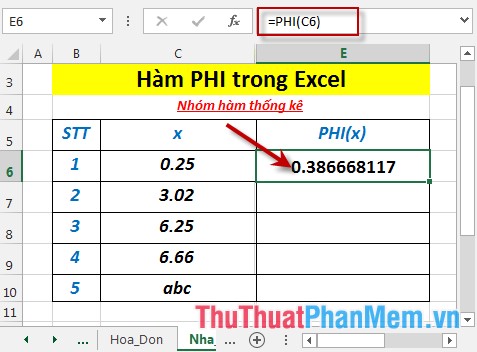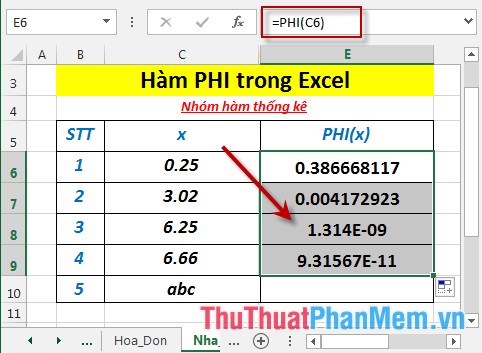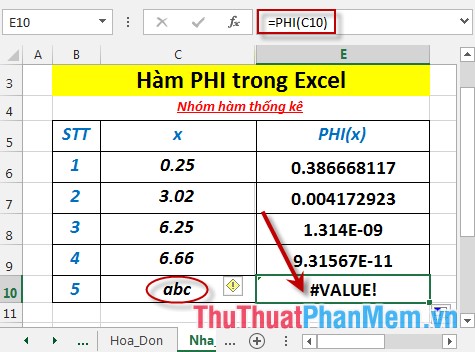PHI function - The function returns the value of the density function for a normal distribution in Excel
The following article introduces you to the PHI function - one of the functions in the statistical function group is very popular in Excel.

Description: The function returns the value of the density function for a standard normal distribution. Support functions from Excel 2013 onwards.
Syntax: PHI (x)
Inside:
- x: The value you want to determine normalized distribution, is a required parameter .
Attention:
- If x is not numeric -> the function returns the #VALUE! Error value
- If x is an invalid numeric value -> the function returns the #NUM! Error value
For example:
Calculate the value of the density function for a standard normal distribution described in the following data table:

- In the cell to calculate enter the formula : = PHI (C6)

- Press Enter -> normalized density function value of 0.25 is:

- Similarly copying the formula for the remaining values results:

- Where x is not a number -> the function returns the #VALUE! Error value

Above are instructions and some specific examples when using the PHI function in Excel.
Good luck!
You should read it
- POISSON.DIST function - The function returns the Poisson distribution in Excel
- POISSON function - The function returns the Poisson distribution in Excel
- GAMMA.INV function - The function returns the inverse of the gamma distribution in Excel
- FISHER function - The function returns the Fissher transformation at x in Excel
- CHIDIST function - Function returns the right end probability of the distribution when squared in Excel
- GAMMA.DIST function - The function returns the gamma distribution in Excel
 POISSON.DIST function - The function returns the Poisson distribution in Excel
POISSON.DIST function - The function returns the Poisson distribution in Excel QUARTILE.EXC function - The function returns the quartile of a dataset without values 0 and 1 in Excel
QUARTILE.EXC function - The function returns the quartile of a dataset without values 0 and 1 in Excel QUARTILE.INC function - The function returns the quartile of a dataset including values 0 and 1 in Excel
QUARTILE.INC function - The function returns the quartile of a dataset including values 0 and 1 in Excel RANK.AVG function - The function returns the rank of a number in a list of numbers in Excel
RANK.AVG function - The function returns the rank of a number in a list of numbers in Excel RSQ - The function returns the square of the Pearson torque correlation coefficient in Excel
RSQ - The function returns the square of the Pearson torque correlation coefficient in Excel SKEW function - The function returns the deviation of the distribution in Excel
SKEW function - The function returns the deviation of the distribution in Excel